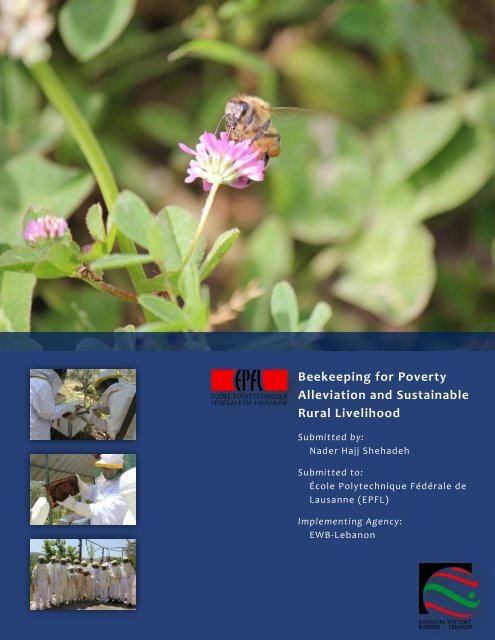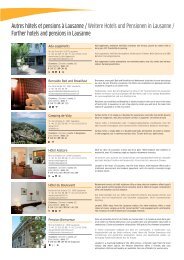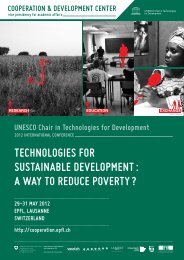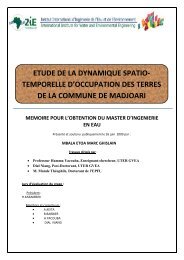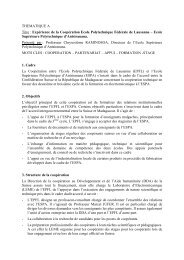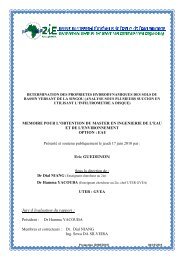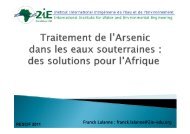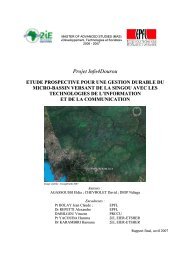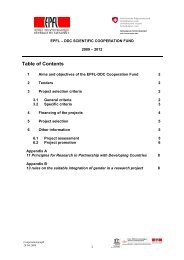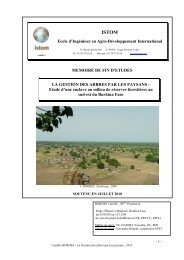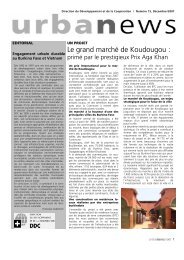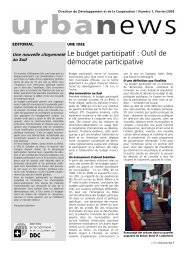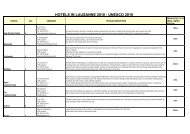Beekeeping for Poverty Alleviation and Sustainable Rural Livelihood
Beekeeping for Poverty Alleviation and Sustainable Rural Livelihood
Beekeeping for Poverty Alleviation and Sustainable Rural Livelihood
Create successful ePaper yourself
Turn your PDF publications into a flip-book with our unique Google optimized e-Paper software.
<strong>Beekeeping</strong> <strong>for</strong> <strong>Poverty</strong><br />
<strong>Alleviation</strong> <strong>and</strong> <strong>Sustainable</strong><br />
<strong>Rural</strong> <strong>Livelihood</strong><br />
Submitted by:<br />
Nader Hajj Shehadeh<br />
Submitted to:<br />
École Polytechnique Fédérale de<br />
Lausanne (EPFL)<br />
Implementing Agency:<br />
EWB-Lebanon<br />
May 05, 2012
Project Development Report
ABSTRACT<br />
Around 21% if the Lebanese population lives in the poor zone, with 39% of them living under<br />
conditions of extreme poverty, most of which inhabit in rural areas.<br />
It is becoming a challenge to empower rural regions <strong>and</strong> prevent deteriorating living<br />
conditions from spreading in remote areas. The areas where agricultural activities are mainly<br />
concentrated, characterizing with insufficient diversification <strong>and</strong> high risk due to unstable<br />
environmental conditions.<br />
In these regions, the majority of people live on subsistence farming <strong>and</strong> producing few<br />
crops, which makes them vulnerable to shocks of all kinds. What is really needed to alleviate<br />
living conditions <strong>and</strong> improve the situation of rural farmers is a low risk high revenue activity<br />
that provides them with additional revenue <strong>and</strong> acts as an aiding activity.<br />
<strong>Poverty</strong> is a main characteristic of remote rural areas, but not the only one. <strong>Rural</strong> regions of<br />
Lebanon are rich in trees <strong>and</strong> diversified plants, which makes it very suitable <strong>for</strong> beekeeping<br />
<strong>and</strong> honey production activities. But because of the lack in income <strong>and</strong> technical experience<br />
in this field, farmers have been tending to avoid beekeeping <strong>and</strong> limiting their activities to<br />
traditional farming only, which is eventually affecting the whole ecosystem, <strong>and</strong> further<br />
exacerbating the problems of livelihood.<br />
Engineers Without Borders Lebanon launched a project to support farmers in rural regions<br />
in Lebanon through a small scale project as a first step to portray the untapped potential <strong>for</strong><br />
strategically investing in apiculture, particularly in beekeeping, as a viable alternative means<br />
of income <strong>for</strong> the most disadvantaged families in rural areas of Lebanon. This would further<br />
increase the capacity of the community to break out of poverty.<br />
The project constitutes of two phases. The fist starts with one family that will be committed<br />
to provide EWB-Lebanon with the swarming colonies. The second phase identifies a new<br />
family <strong>and</strong> provides it with bee colonies to repeat the same process as in phase 1.<br />
i
The project supports poor families in rural areas of Lebanon through introducing the<br />
concept of sustainable beekeeping <strong>and</strong> providing them with education, financial support,<br />
<strong>and</strong> technical cooperation in the field. Aiming at achieving the following results:<br />
1) Increase the technical knowledge <strong>and</strong> skills of small scale beekeepers<br />
2) Increase the income of beneficiaries<br />
3) Provide the transition to ecological honey production<br />
4) Provide safe <strong>and</strong> healthy honey to consumer<br />
5) Promote working groups <strong>and</strong> networking potential<br />
The project period starts in 2012 <strong>and</strong> ends in 2014, with an overall budget of $4,400, of which<br />
$1,200 are in kind contribution, <strong>and</strong> 1,700 are secured through a contribution from EWB-<br />
Lebanon <strong>and</strong> a sponsorship by an environmental company. The rest $1,500 are required <strong>for</strong><br />
second phase of the project <strong>and</strong> would be secured through fundraising <strong>and</strong> sponsorships.<br />
This report presents the project implemented by EWB-Lebanon in partial fulfillment of the<br />
CAS in Management of Development Projects, <strong>and</strong> states the steps taken <strong>and</strong> the<br />
achievements accomplished in collaboration with local partners.<br />
The contents of the report are not meant to provide a project evaluation or a complete<br />
project proposal; it is limited to project description <strong>and</strong> presentation of major activities.<br />
Keywords: <strong>Beekeeping</strong>, <strong>Rural</strong> development, Apiculture, <strong>Sustainable</strong> rural livelihood<br />
ii
LIST OF FIGURES, TABLES, AND APPENDICES<br />
Figure 1: The major five beekeeping capital assets 4<br />
Figure 2: The action plan timeline <strong>for</strong> phase 1 9<br />
Table 1: Logical framework analysis 6<br />
Table 2: Action plan <strong>for</strong> the first phase of the project 8<br />
Table 3: Responsibility Matrix 10<br />
Table 4: Budget of the project over the three phases 11<br />
Table 5: Financing of the project in its three phases 12<br />
Table 6: The major steps of project evaluation 17<br />
Appendix A: The Survey Questionnaire 20<br />
Appendix B: Results of Survey: Major obstacles <strong>and</strong> problems 23<br />
Appendix C: Selection Criteria of the Family 24<br />
Appendix D: List of material needed <strong>for</strong> phase 1 25<br />
Appendix E: Beekeeper’s manual 26<br />
iii
TABLE OF CONTENTS<br />
Abstract _____________________________________________________________________ i<br />
List of Figures, Tables, <strong>and</strong> Appendices ___________________________________________ iii<br />
Introduction __________________________________________________________________ 1<br />
Background______________________________________________________________________ 1<br />
Project Description ________________________________________________________________ 1<br />
Project Planning _______________________________________________________________ 3<br />
Baseline Analysis <strong>and</strong> Needs Assessment ______________________________________________ 3<br />
Project Design____________________________________________________________________ 4<br />
Logical Framework ________________________________________________________________ 6<br />
Project Implementation ________________________________________________________ 7<br />
Implementation Strategy ___________________________________________________________ 7<br />
Financing _______________________________________________________________________ 11<br />
Feasibility Analysis _______________________________________________________________ 13<br />
Implementation Achievements __________________________________________________ 14<br />
Monitoring <strong>and</strong> Evaluation System _______________________________________________ 16<br />
Monitoring _____________________________________________________________________ 16<br />
Evaluation ______________________________________________________________________ 16<br />
Conclusion __________________________________________________________________ 18<br />
Challenges ______________________________________________________________________ 18<br />
SustainabIlity of the Project _______________________________________________________ 18<br />
Appendices __________________________________________________________________ 20<br />
iv
INTRODUCTION<br />
BACKGROUND<br />
Lebanon is a developing country in the Middle East with a urbanization rate of around 90%<br />
<strong>and</strong> growing. In this high middle income country, it is becoming a challenge to empower<br />
rural regions <strong>and</strong> prevent demoted living conditions from spreading in remote areas, where<br />
agricultural activities are mainly concentrated. <strong>Poverty</strong> is a main characteristic of remote<br />
rural areas in Lebanon, which is mainly caused by the lack of diversified source of income.<br />
<strong>Beekeeping</strong> is known to have many attractions <strong>for</strong> rural farmers, as this activity does not<br />
require daily attention <strong>and</strong> does not really take up valuable l<strong>and</strong> or time which would have<br />
been spent on other farming activities. In rural communities where availability of financing is<br />
limited <strong>and</strong> constricted to certain agricultural activities, small-scale beekeeping can<br />
contribute significantly to livelihood security.<br />
It is estimated that there are around 5,250 beekeepers in Lebanon running around 175,000<br />
beehives all over the country. The market is dominated by big beekeeping industrialists with<br />
massive honey production, each running more than 200 beehives. While small beekeepers<br />
have no more than 20 beehives each with most of them with less than 10 beehives mainly<br />
dedicated <strong>for</strong> honey production. The number of small beekeepers is decreasing<br />
tremendously, caused mainly by the uncontrolled loss of beehives <strong>and</strong> improper<br />
implementation of technical skills.<br />
PROJECT DESCRIPTION<br />
The project starts by selecting one poor family from a rural region in Lebanon with previous<br />
experience in beekeeping, <strong>and</strong> works closely with the family members to reconsider<br />
beekeeping as a side activity to help produce natural honey.<br />
The family is supplied with the tools <strong>and</strong> equipment needed to per<strong>for</strong>m beekeeping<br />
activities, <strong>and</strong> provided with bee colonies in eight beehives to be raised <strong>and</strong> used <strong>for</strong> honey<br />
as well as queen bee production.<br />
1
The role of EWB-Lebanon is to provide the material <strong>and</strong> lead training <strong>and</strong> educational<br />
sessions in partnership with local experts in the field. The beneficiary is committed to keep<br />
close coordination with the organization <strong>for</strong> a period of two years, reporting problems <strong>and</strong><br />
following the recommendations of the team leader.<br />
This all is offered to the beekeeper free of charge, the only requirement the family should<br />
commit to is to capture <strong>and</strong> keep the new bee colonies created through artificial or natural<br />
swarming in good condition <strong>for</strong> the period of two years. EWB-Lebanon will collect the new<br />
colonies <strong>and</strong> use them to implement a similar activity in the second phase of the project with<br />
another underdeveloped family. EWB-Lebanon has the right to per<strong>for</strong>m artificial swarming<br />
only once <strong>for</strong> each beehive during the project period.<br />
The beekeeper is also asked to participate in future training sessions <strong>and</strong> train other<br />
beekeepers in later phases of the project.<br />
The second phase of the project starts while still coordinating with the first beneficiary.<br />
During this phase the same process will be repeated with a new family to create a<br />
sustainable activity at reduced costs.<br />
PROJECT SUMMARY<br />
Title:<br />
<strong>Beekeeping</strong> <strong>for</strong> <strong>Poverty</strong> <strong>Alleviation</strong> <strong>and</strong> <strong>Sustainable</strong> <strong>Rural</strong> <strong>Livelihood</strong><br />
Organization: Engineers Without Borders – Lebanon (www.ewb-lebanon.org)<br />
Donor:<br />
Green Arms (www.greenarms.co.uk)<br />
Partner:<br />
Eiffel Association <strong>for</strong> <strong>Beekeeping</strong><br />
Location:<br />
Underdeveloped rural regions in Lebanon<br />
Period: 2012 – 2014<br />
Target Group: Former beekeepers <strong>and</strong> unemployed young people<br />
Overall Budget: $4,400<br />
Team Leader: Nader Hajj Shehadeh (nader@ewb-lebanon.org)<br />
2
PROJECT PLANNING<br />
The project cycle includes two major phases starting with the design phase that involves<br />
baseline analysis, needs assessment, <strong>and</strong> project design, <strong>and</strong> then the implementation phase<br />
including planning, implementation, <strong>and</strong> followed by a monitoring <strong>and</strong> evaluation system.<br />
BASELINE ANALYSIS AND NEEDS ASSESSMENT<br />
In order to learn about the current situation <strong>and</strong> the problems facing the target group, a<br />
participatory approach baseline analysis is per<strong>for</strong>med to better underst<strong>and</strong> the reality of the<br />
issues, how they interrelate, how they evolved, <strong>and</strong> how urgent they rank. Needs<br />
assessment is also per<strong>for</strong>med to identify, prioritize, <strong>and</strong> level the needs.<br />
The target group in this case is the local community, which makes it most appropriate to<br />
start the situation analysis there <strong>and</strong> then extend the perspective gradually. So the ripple<br />
starts with the inhabitants of rural areas who live in poor conditions, <strong>and</strong> then moves out to<br />
the farmers <strong>and</strong> families conducting agricultural activities. These groups are met r<strong>and</strong>omly in<br />
poor regions of the country <strong>and</strong> interviewed to underst<strong>and</strong> their needs <strong>and</strong> problems.<br />
The third level includes meetings with beekeepers <strong>and</strong> those who used to be in business but<br />
stopped <strong>for</strong> any reason, to conclude with a fourth level that included beekeeping experts<br />
<strong>and</strong> suppliers who have good experience about the situation in rural areas <strong>and</strong> the problems<br />
facing small scale beekeepers.<br />
The research per<strong>for</strong>med has identified a root cause of poverty in the rural regions of the<br />
country, which turned out to be the lack of diversified sources of income <strong>and</strong> the restriction<br />
to certain agricultural activities.<br />
It also reached basic conclusions regarding the decrease in beekeeping activities <strong>and</strong> giving<br />
away this additional source of income. It was clear that the low technical skills <strong>and</strong> the lack<br />
of financial support have been playing a major role in reducing the interest of local farmers<br />
<strong>and</strong> agricultural workers in beekeeping <strong>and</strong> honey production.<br />
The survey questionnaire is originally per<strong>for</strong>med in Arabic. A translated version with the<br />
results of the survey is presented in appendices A <strong>and</strong> B.<br />
3
On another note, national reports <strong>and</strong> studies show that Lebanon imports around 50% of its<br />
honey consumption, which is due to the insufficiency of honey supplied locally. This has<br />
raised the issue of the instauration of the market, <strong>and</strong> the deficit in supply that has not been<br />
able to meet the dem<strong>and</strong>. From this perspective, honey products seem to still have enough<br />
room in the market, which is tending to dem<strong>and</strong> local production rather than imported<br />
products.<br />
PROJECT DESIGN<br />
The overall project’s target group is selected to be poor farmers from rural areas, with an<br />
aim to provide them with additional sources of income <strong>and</strong> reduce their insecurity.<br />
Honey production has been reported to be a reliable revenue generating activity, with a very<br />
high rate of business development. The results of survey conducted among farmers <strong>and</strong><br />
rural inhabitants, this activity seems to be interesting <strong>and</strong> favored by almost all respondents,<br />
but should be provided with sufficient technical <strong>and</strong> financial support.<br />
To do so, the five major capital assets of beekeeping are identified <strong>and</strong> discussed individually<br />
to remove barriers <strong>and</strong> create sustainability in this activity, based on which the actions <strong>and</strong><br />
initiatives are planned to compliment the needs of the beekeepers as identified through the<br />
needs assessment process. The main assets are shown in Figure 1.<br />
Natural<br />
Financial<br />
<strong>Beekeeping</strong><br />
Capital<br />
Assets<br />
Social<br />
Physical<br />
Human<br />
Figure 1: The major five beekeeping capital assets<br />
4
(1) The natural capital:<br />
It includes bee colonies, productive l<strong>and</strong> field, <strong>and</strong> good environmental resources. The<br />
first is supplied by the project, while the rest should be originally available to ensure<br />
sufficient resources <strong>for</strong> productive beekeeping.<br />
(2) The social capital<br />
The social capital includes support offered by neighbors, family, friends, <strong>and</strong> networks.<br />
This is necessary to provide access to more resources, in<strong>for</strong>mation, support, <strong>and</strong><br />
associations. It is not expected to have all this available, but the project would work on<br />
increasing the social capital <strong>and</strong> creating more efficient networking.<br />
(3) The human capital<br />
This is a major asset that includes the technical <strong>and</strong> practical skills, knowledge, marketing<br />
expertise, health <strong>and</strong> good physical conditions. For the first phase of the project, it is<br />
required to have some basic expertise already available in an aim to reduce startup risk,<br />
while in the other phases there are no restrictions or minimum requirements.<br />
The project focuses on capacity building <strong>and</strong> trainings among beekeepers <strong>and</strong> other<br />
family members to enhance the human capital.<br />
(4) The physical capital<br />
This includes the tools <strong>and</strong> equipment needed <strong>for</strong> beekeeping. These should be made<br />
available by the project, <strong>and</strong> the beekeepers will be trained to use them properly <strong>and</strong><br />
avoid any contamination or improper applications.<br />
(5) The financial capital<br />
This includes the availability of cash <strong>and</strong> credit loans, which is normally inexistent <strong>for</strong> the<br />
poor living in rural areas. It is required <strong>for</strong> the development of the business, <strong>and</strong> should<br />
be ensured in case the beekeepers wish to exp<strong>and</strong> the beekeeping activities at a later<br />
stage.<br />
5
LOGICAL FRAMEWORK<br />
Table 1: Logical framework analysis<br />
Project Structure Intervention Logic Indicators Means of Verification Assumptions<br />
Development<br />
Objective<br />
Immediate<br />
Objective<br />
- Create a viable source of income<br />
- <strong>Sustainable</strong> rural development<br />
- Agricultural diversification<br />
- Giving farmers a new skill<br />
Improved livelihood of rural farmers<br />
through beekeeping<br />
- Additional income<br />
- At least $1,000 by 2013<br />
Outputs Bee colonies are provided - Delivery of 8 colonies<br />
- Delivery by April 2012<br />
The concept of beekeepers’<br />
network is initiated<br />
Technical <strong>and</strong> marketing trainings<br />
are conducted regularly<br />
Learning material is provided<br />
- The concept is starting to<br />
evolve<br />
- Number of trainings<br />
- Number of attendees<br />
- Level of underst<strong>and</strong>ing<br />
- Availability of learning<br />
material with beekeeper<br />
- Interview<br />
- statistics of sold items<br />
- Good environmental<br />
conditions<br />
- Filed visit - Stability in weather<br />
- Swarming on time<br />
- Interviews with<br />
beekeepers<br />
- Training report<br />
- Interview<br />
- Test ability to train<br />
- Availability of<br />
beekeepers around<br />
- Expert’s availability<br />
- Meetings - Availability of material<br />
Required tools, equipment, <strong>and</strong><br />
preventive care are offered<br />
- Availability of material<br />
with the beekeeper<br />
- Interview<br />
- Site inspection<br />
- Purchase from<br />
supplier<br />
Special discounts <strong>for</strong> beekeeping<br />
are secured<br />
- Discount rate offered - Interview supplier<br />
- Interview beekeeper<br />
- Agreement with<br />
supplier<br />
Activities<br />
Presented in the action plan<br />
6
PROJECT IMPLEMENTATION<br />
IMPLEMENTATION STRATEGY<br />
Selection of family<br />
The project starts with one family identified after a primary selection of several families in<br />
various rural regions of the country. The final list included four families in different regions,<br />
one from Nabatieh (South Lebanon), another from Dannieh (North Lebanon), <strong>and</strong> two<br />
families from Richmaya <strong>and</strong> Shheem in the mountains of Lebanon. The selection criterion is<br />
explained in Appendix C, with the shortlisted families scoring 22, 21, 28, <strong>and</strong> 24 respectively.<br />
For the first phase of the project, the family in Richmaya is selected. The family consists of<br />
four members, with the father being a farmer <strong>for</strong> more than 20 years. Their major income<br />
comes from farming activities, specifically ground plants, cattle raising, <strong>and</strong> cultivars, <strong>and</strong> is<br />
estimated to be a net of around $10,000 per annum.<br />
Michel, the head of the family, tried to raise bees <strong>for</strong> a couple of years, but failed to maintain<br />
his beehives <strong>and</strong> lost all his bees <strong>for</strong> unknown diseases.<br />
Action plan<br />
The action items are set based on logical framework matrix prepared <strong>and</strong> the major capital<br />
assets discussed earlier, within each there exist several action items <strong>and</strong> activities to be<br />
implemented.<br />
The action plan includes 10 major components, each with specific actions making a total of<br />
15 activities to be implemented over the project period.<br />
The action items are implemented by EWB-Lebanon in coordination with other partnering<br />
organizations.<br />
Except <strong>for</strong> item A.1.a, this process is repeated <strong>for</strong> new beneficiaries after getting new bee<br />
colonies through artificial <strong>and</strong>/or natural swarming. For the next phase, farmers are asked to<br />
either build their own beehives or buy them from a local supplier.<br />
7
Table 2: Action plan <strong>for</strong> the first phase of the project<br />
Capital Asset Components Activities<br />
A. Natural Capital 1. Provide bee colonies a. Buy 8 beehives with bee colonies (4 full frames per beehive)<br />
b. Delivery beehives to the location<br />
2. Ensure environmental resources a. Educate beekeepers about the importance of natural farming<br />
B. Social Capital 1. Create beekeepers’ network a. Gather beekeepers <strong>and</strong> professionals in the region<br />
C. Human Capital 1. Technical trainings a. Provide a learning session on beekeeping <strong>and</strong> honey products<br />
b. Conduct a practical training on the basics of beekeeping<br />
c. Conduct a training on artificial swarming<br />
d. Conduct a training on building <strong>and</strong> assembly of beehives<br />
e. Provide professional support on major diseases<br />
2. Marketing trainings a. Help the beekeeper market the produced honey<br />
3. Learning material a. Provide an operation guide in partnership with the expert<br />
b. Provide guides on diseases <strong>and</strong> treatment methods<br />
4. Follow-up <strong>and</strong> coordination a. Offer help <strong>and</strong> coordination with the beekeeper <strong>for</strong> 2 years<br />
D. Physical Capital 1. Provide tools <strong>and</strong> equipment a. Provide all necessary equipment needed (Appendix D)<br />
2. Provide preventive care material a. Provide all necessary supplies (Appendix D)<br />
E. Financial Capital 1. Get special discounts <strong>for</strong> beekeeping a. Secure special discounts <strong>for</strong> future development<br />
8
Action plan timeline<br />
The action plan very much depends on the weather conditions <strong>and</strong> other environmental<br />
factors, which might cause some delays <strong>and</strong> changes in the timeline, but would be in a<br />
tolerable range.<br />
The work plan is set annually, <strong>and</strong> is repeated in similar patterns <strong>for</strong> the different phases of<br />
the project. The timeline expressed below is <strong>for</strong> phase 1 with one family only. The swarming<br />
activity cannot be set in a specific month as this depends on the activity of the bee colony<br />
<strong>and</strong> the weather conditions. When swarming takes place, a month later the process will be<br />
repeated <strong>for</strong> the new family in phase 2.<br />
Figure 2: The action plan timeline <strong>for</strong> phase 1<br />
Coordination <strong>and</strong> responsibilities<br />
The project implementation is led by a team leader, supported by a project assistant who is<br />
developing an expertise in the field of beekeeping. Other volunteers from the team of EWB-<br />
Lebanon join the project team to participate in different activities as assigned by the team<br />
9
leader whose major role is to coordinate among the different key players of the project. he<br />
plays the role of the focal point <strong>and</strong> the manager of the activities planned <strong>and</strong> undertaken.<br />
Table 3: Responsibility Matrix<br />
Activity Responsible Staff Implementing<br />
Partner<br />
Buy 8 beehives with bee colonies<br />
Delivery beehives to the location<br />
Educate beekeepers about the importance of natural<br />
farming<br />
Gather beekeepers <strong>and</strong> professionals in the region<br />
Provide a learning session on beekeeping <strong>and</strong> honey<br />
products<br />
Conduct a practical training on the basics of<br />
beekeeping<br />
Project Leader<br />
Project Assistant<br />
Project Leader<br />
Project Assistant<br />
Project Assistant<br />
<strong>Beekeeping</strong> Expert<br />
Project Leader<br />
Beneficiary<br />
Project Leader<br />
Project Assistant<br />
<strong>Beekeeping</strong> Expert<br />
Project Assistant<br />
<strong>Beekeeping</strong> Expert<br />
Eiffel<br />
Green Arms<br />
Eiffel<br />
Green Arms<br />
Eiffel<br />
Eiffel<br />
Conduct a training on artificial swarming <strong>Beekeeping</strong> Expert Eiffel<br />
Conduct a training on building <strong>and</strong> assembly of<br />
beehives<br />
Provide professional support on major diseases<br />
Project Leader<br />
Project Assistant<br />
Project Assistant<br />
<strong>Beekeeping</strong> Expert<br />
Eiffel<br />
Help the beekeeper market the produced honey Project Team Eiffel<br />
Provide an operation guide in partnership with the<br />
expert<br />
Project Leader<br />
Project Assistant<br />
<strong>Beekeeping</strong> Expert<br />
Eiffel<br />
Provide guides on diseases <strong>and</strong> treatment methods Project Assistant Eiffel<br />
Offer help <strong>and</strong> coordination with the beekeeper <strong>for</strong> 2<br />
years<br />
Provide all necessary equipment needed<br />
Provide all necessary supplies<br />
Project Leader<br />
Project Assistant<br />
<strong>Beekeeping</strong> Expert<br />
Project Leader<br />
Project Assistant<br />
Project Leader<br />
Project Assistant<br />
Eiffel<br />
Eiffel<br />
Eiffel<br />
Secure special discounts <strong>for</strong> future development Project Leader Eiffel<br />
10
FINANCING<br />
Budget<br />
The major expenses of the project are the bee colonies <strong>and</strong> the equipment needed including<br />
suits <strong>and</strong> beehives. Training sessions <strong>and</strong> capacity building are provided free of charge by a<br />
partner organization <strong>for</strong> the first phase of the project. For other phases the participants of<br />
the previous training sessions would be training new beekeepers in coordination with the<br />
experts hired by the partner organization. This would ensure sustainability of the transfer of<br />
know-how, <strong>and</strong> help create strong links between beneficiaries.<br />
No administrative costs are claimed as the project team is participating on voluntary basis,<br />
<strong>and</strong> members are committed to the implementation of the project with no financial returns.<br />
The budget set <strong>for</strong> this project over three phases is $3,553 as described in details in Table 4.<br />
Table 4: Budget of the project over the three phases<br />
Quantity<br />
Item Unit Phase 1 Phase 2 Phase 3 Total Unit Price Total Price<br />
Beehives + Bees hive 8 0 0 8 $120.0 $960.0<br />
Beekeeper's Suit pc 4 2 2 8 $60.0 $480.0<br />
Smoker pc 1 1 1 3 $12.0 $36.0<br />
Hive Tool pc 1 1 1 3 $4.0 $12.0<br />
Feeder (8 liters) pc 2 2 2 6 $13.0 $78.0<br />
Brush pc 1 1 1 3 $4.5 $13.5<br />
Vitamins 1 liter 1 1 1 3 $13.0 $39.0<br />
Proteins 1 liter 1 1 1 3 $13.0 $39.0<br />
Feed Box (12) 2 2 2 6 $32.0 $192.0<br />
Anesthetic Box 1 1 1 3 $4.5 $13.5<br />
Anti-Varroa pc 16 16 16 48 $5.0 $240.0<br />
Anti-Swarming box 1 1 1 3 $10.0 $30.0<br />
Swarming Tools box 0 8 0 8 $20.0 $160.0<br />
Hornets Trap pc 2 2 2 6 $10.0 $60.0<br />
Transportation - 10 10 10 30 $30.0 $900.0<br />
Miscellaneous - 1 1 1 3 $100.0 $300.0<br />
Total $ 3,553.0<br />
11
Partners<br />
During the first phase, EWB-Lebanon has two major partners that financially <strong>and</strong> technically<br />
contributed to the implementation of the project. For the other two phases, the<br />
implementation committee at EWB-Lebanon would be looking <strong>for</strong> new donors interested in<br />
participating <strong>and</strong> helping this project.<br />
The partners’ kind contributions were sufficient to ensure successful implementation of the<br />
first phase of the project. The major partners during the first phase of the project are Green<br />
Arms <strong>and</strong> Eiffel Association <strong>for</strong> <strong>Beekeeping</strong>.<br />
Green Arms is a Lebanese association involved in sustainability projects <strong>and</strong> environmental<br />
friendly activities. Bernard Ammoun, the CEO of Green arms, contributed with an amount of<br />
$1,200 to partially finance the first phase of the project.<br />
Eiffel Association <strong>for</strong> <strong>Beekeeping</strong> is a leading beekeeping association supplying beekeeping<br />
equipment <strong>and</strong> material <strong>and</strong> offering apiculture consultancy in Lebanon <strong>and</strong> the Middle East.<br />
It is recognized as a major producer of beekeeping food supplies. Eiffel Association <strong>for</strong><br />
<strong>Beekeeping</strong> provided an in-kind contribution by offering their expertise <strong>and</strong> knowledge<br />
through training sessions, <strong>and</strong> offering EWB-Lebanon special discounts on the product<br />
purchased <strong>for</strong> the benefit of this project.<br />
Table 5: Financing of the project in its three phases<br />
Quantity<br />
Item Type Phase 1 Phase 2 Phase 3 Total Price<br />
Green Arms Cash $1,200 $0 $0 $1,200.0<br />
EWB-Lebanon Cash $500 $0 $0 $500.0<br />
In-kind $200 $200 $200 $600.0<br />
Eiffel Association In-kind $200 $200 $200 $600.0<br />
Donor 2 Cash $0 $750 $0 $750.0<br />
Donor 3 Cash $0 $0 $750 $750.0<br />
Total $4,400.0<br />
12
FEASIBILITY ANALYSIS<br />
From the beekeeper’s point of view, beekeeping is by far one of the most feasible activities<br />
in terms of finance. A beehive would cost around $150 a year (including running costs), but<br />
would generate an income that could exceed this investment.<br />
There are two type of income generating possibilities, the first from selling bee colonies that<br />
are naturally reborn (swarming) an average of once a year. A bee colony is sold at an<br />
average of $80 at the current rates.<br />
The other source of income would be the sale of honey, which is currently rated at $20 per<br />
kg. With an average honey production yield of 8 kg/beehive, a single colony would generate<br />
an income of $160 per year.<br />
The project being implemented would eliminate the first source of income <strong>for</strong> the first two<br />
years, as new colonies would be used <strong>for</strong> other projects, <strong>and</strong> thus the income generation <strong>for</strong><br />
the whole period of the project would be $2,560.<br />
13
IMPLEMENTATION ACHIEVEMENTS<br />
Up to the date this report is issued, the project team has successfully implemented the<br />
following activities:<br />
Selection of the beneficiary (November 2011 – February 2012)<br />
The planning of the project started by the end of 2011, the selection of the beneficiary was<br />
done by January 2012, after paying visits <strong>and</strong> conducting interviews with the potential<br />
beneficiaries.<br />
Several meetings were conducted with the beneficiary to explain the project <strong>and</strong> define the<br />
commitments of each party.<br />
Fundraising (February – February 2012)<br />
The project was presented to several potential donors<br />
including environmental organizations, farmers’ associations,<br />
private companies, <strong>and</strong> individuals. Negotiations started with<br />
the CEO of green arms in February 2012 <strong>and</strong> were continued<br />
with a more solid proposal in March 2012, when the company<br />
decided to contribute with an amount of $1,000 to the<br />
project. At a later stage the contribution was increased to $1,200 paid in cash.<br />
Purchase of equipment (March – April 2012)<br />
There are only a few suppliers of beekeeping equipment in Lebanon, on top of which is Eiffel<br />
Association <strong>for</strong> <strong>Beekeeping</strong>, which is considered a leading company in supplying material<br />
<strong>and</strong> food supplies, as well as bee colonies of high quality.<br />
The managing director of Eiffel Association, decided to provide a special discount of 10% to<br />
all equipment purchased <strong>for</strong> the benefit of this development project. In addition, the<br />
association offered one of its best experts, Mr. Ahmad Kassar, to lead training sessions <strong>and</strong><br />
provide technical expertise.<br />
14
Delivery of equipment (April 2012)<br />
On the night of April 18, 2012, eight beehives <strong>and</strong> related<br />
equipment were delivered to the site. Mr. Michel El Hachem<br />
was available to receive the beehives <strong>and</strong> place them on the<br />
special rack built <strong>for</strong> this purpose.<br />
The rest of the equipment was delivered during the first<br />
training day on April 22, 2012.<br />
Training on the basics of beekeeping (April 2012)<br />
On the 22 nd of April, a training session on the basics of<br />
beekeeping was conducted in Richmaya. The training was<br />
given by an expert from Eiffel Association <strong>for</strong> beekeeping<br />
<strong>and</strong> attended by 15 participants including the farmer <strong>and</strong> his<br />
family, in addition to other potential beneficiaries, a group<br />
from the main partner, <strong>and</strong> project participants from EWB-<br />
Lebanon.<br />
The training was preceded by a theoretical session given by the beekeeping expert at EWB-<br />
Lebanon about the bee colony <strong>and</strong> the different types of bees.<br />
Beekeeper’s operation manual (April 2012)<br />
A manual <strong>for</strong> good beekeeping practices was prepared by<br />
EWB-Lebanon team with the support from the beekeeping of<br />
the partnering association. The leaflet manual provided<br />
guidelines <strong>for</strong> the beekeeper to better manage his beehives.<br />
(See Appendix E)<br />
15
MONITORING AND EVALUATION SYSTEM<br />
MONITORING<br />
In order to ensure the project is going on track <strong>and</strong> guarantee that various activities are<br />
undertaken as specified in the plan, first level monitoring is per<strong>for</strong>med by the organization’s<br />
staff who routinely gather in<strong>for</strong>mation on all aspects of the project <strong>and</strong> arrange field visits<br />
to make sure the implementation of the project is going by the commitments set during the<br />
initiation of the activity.<br />
Project staff conduct weekly visits during the first month of the implementation (May 2012),<br />
<strong>and</strong> to discuss with the beekeeper the progress <strong>and</strong> the problems faced if any.<br />
Starting June, the frequency of inspection visits would be reduced to then become once a<br />
month. Monitoring reports are prepared by the project team upon each visit conducted.<br />
The monitoring report includes the activities that need to be monitored, with the deadlines<br />
<strong>and</strong> due times set <strong>for</strong> each activity. It also includes the current progress <strong>and</strong> the steps taken<br />
up to date, presenting the barriers faced <strong>and</strong> the solutions that have been proven to be<br />
effective.<br />
EVALUATION<br />
The evaluation criterion <strong>for</strong> the implemented development project includes process <strong>and</strong><br />
impact evaluation.<br />
Process evaluation is done at the end of the first year of the project to review goals,<br />
strategies, <strong>and</strong> work plans, based on which modifications <strong>and</strong> improvements are<br />
implemented through a constructive re-planning process.<br />
Impact evaluation is per<strong>for</strong>med at the end of the project to investigate whether or not the<br />
project has achieved its goals <strong>and</strong> attempts. It looks at the impact of the project <strong>and</strong> its<br />
effect on the beneficiaries <strong>and</strong> participants through sustainable development. This is done<br />
through data collection, surveys, interviews, <strong>and</strong> cost-benefit analysis at the beneficiary’s<br />
level.<br />
16
The evaluation process <strong>for</strong> this project includes 6 major steps as shown in Table 6.<br />
Table 6: The major steps of project evaluation<br />
Purpose of evaluation<br />
The evaluation is done to investigate the effectiveness <strong>and</strong><br />
applicability of the project.<br />
It is done <strong>for</strong> EWB-Lebanon personal use, <strong>and</strong> can be shared with<br />
the donors <strong>and</strong> partnering agencies.<br />
Priority areas<br />
In<strong>for</strong>mation collection<br />
Implementation plan<br />
- Feasibility of the project<br />
- Sustainability of the activity<br />
- Impact on the beneficiary<br />
- Development of technical knowledge<br />
- Effect on rural development<br />
- Surveys<br />
- Interviews with the beneficiary<br />
- Inspection visits<br />
- Testing the technical knowledge development at the<br />
beneficiary level<br />
- Calculation income contribution<br />
Evaluation committee: Project leader <strong>and</strong> project assistant from<br />
EWB-Lebanon<br />
Budget: $0 (Done on voluntary basis)<br />
In<strong>for</strong>mation analysis<br />
Follow up<br />
The evaluation committee presents the results to the project<br />
committee, where the decision pertaining to the impact <strong>and</strong><br />
per<strong>for</strong>mance of this project shall be made.<br />
- Project committee meeting to discuss the results <strong>and</strong> analyze<br />
the barriers<br />
- Meeting with the beneficiary to underst<strong>and</strong> the major issues<br />
- Communicating finding to other involved parties<br />
- Reporting the lessons learnt<br />
17
CONCLUSION<br />
CHALLENGES<br />
The project is still in its beginning, yet it encountered various challenges <strong>and</strong> barriers, mainly<br />
causing frequent adjustments to the timeline of the project. The project team’s major<br />
challenge was to ensure an appropriate balance between the environmental conditions <strong>and</strong><br />
the project requirements.<br />
A delay was caused due to the instability of weather conditions that led to a delay in the<br />
birth of new colonies. In addition, the selection of the first beneficiary was a time consuming<br />
process, with high risk due to the difficulty of fully underst<strong>and</strong>ing the situation prior to<br />
implementation.<br />
On another note, the fact that all these activities were done on voluntary basis, the work<br />
witnessed some delays due to other commitments of the team members especially with the<br />
frequent modifications in the time plan. Some members had already planned <strong>for</strong> other<br />
professional activities <strong>and</strong> had to h<strong>and</strong> in their duties to other members in an aim to keep<br />
the project going on.<br />
SUSTAINABILITY OF THE PROJECT<br />
The project success depends on the sustainability it can achieve, which depends on the<br />
proper implementation of the various components of the project.<br />
By the end of the first year, the beekeeper is expected to be knowledgeable enough to offer<br />
his earned expertise in the training sessions of the following stages of the project. The<br />
know-how learned through training <strong>and</strong> practical experience should be an important asset<br />
<strong>for</strong> the beekeeper <strong>and</strong> the project itself.<br />
Similarly, the project aims to achieve sustainability in the social, financial, institutional, <strong>and</strong><br />
environmental aspects.<br />
Being properly implemented, the project is expected to sustainably improve working<br />
conditions <strong>and</strong> social protection through offering diversification in agricultural activities <strong>and</strong><br />
keeping close coordination throughout the implementation.<br />
18
The financial sustainability of the project is to be achieved through the collection of new<br />
colonies, <strong>and</strong> the minor contributions of the beneficiaries in buying or building their own<br />
beehives. Additional funds are to be secured, <strong>and</strong> sources of revenue will be considered<br />
during the second year of the project.<br />
At the institutional level, the agreement with the beekeepers to give them full ownership of<br />
the bee colonies under the condition of providing swarming bees <strong>for</strong> two years ensures<br />
institutional sustainability.<br />
Last but not least, environmental sustainability has the biggest share due to the important<br />
rile bees play in the pollination of plants <strong>and</strong> the growth of natural resources. As a matter of<br />
fact, the loss of bees has serious consequences <strong>for</strong> plants, wildlife <strong>and</strong>, yes, human survival,<br />
<strong>and</strong> their collapse threatens global food security<br />
And as Einstein once opinioned, “If the bee disappears from the surface of the earth, man<br />
would have no more than four years to live. No more bees, no more pollination … no more<br />
men!”<br />
19
APPENDICES<br />
Appendix A: The Survey Questionnaire<br />
Surveyor:<br />
Date:<br />
General In<strong>for</strong>mation<br />
Name:<br />
Village:<br />
Age:<br />
Phone Number:<br />
Classification:<br />
<strong>Rural</strong> Inhabitant<br />
Farmer<br />
Beekeeper<br />
Supplier<br />
Expert<br />
For those with no previous beekeeping experience<br />
Would you be interested in beekeeping?<br />
Yes<br />
No<br />
Why?<br />
[________________________________________________________________________________]<br />
How many beehives can you h<strong>and</strong>le?<br />
[_________________]<br />
What would you need to become a beekeeper?<br />
[________________________________________________________________________________]<br />
How many natural swarming did you have per year? [_________________]<br />
What are the major reasons stopping you from considering beekeeping?<br />
(Give a rating On a scale of 1 to 5, with 1 being least <strong>and</strong> 5 being highest priority)<br />
[____________________________________________________]<br />
[____________________________________________________]<br />
[____________________________________________________]<br />
[____________________________________________________]<br />
[____________________________________________________]<br />
<br />
<br />
<br />
<br />
<br />
20
Do you have a good l<strong>and</strong> <strong>for</strong> beekeeping?<br />
Yes<br />
No<br />
Is there any use of agricultural pesticides near the location?<br />
Yes<br />
No<br />
Would you be interested in becoming a beekeeper?<br />
Definitely yes<br />
Yes<br />
Not sure<br />
No<br />
Of course not<br />
Would you consider it if we offer you financial <strong>and</strong> technical support?<br />
Definitely yes<br />
Yes<br />
Not sure<br />
No<br />
For those with previous beekeeping experience<br />
Are you still a beekeeper?<br />
Yes<br />
No<br />
How long have you been a beekeeper?<br />
[_________________]<br />
Why did you stop?<br />
[________________________________________________________________________________]<br />
How many beehives did/do you have?<br />
What is the honey production yield?<br />
[_________________]<br />
[_________________]<br />
How many natural swarming did you have per year? [_________________]<br />
What are the major problems you face(d) in beekeeping?<br />
(Give a rating On a scale of 1 to 5, with 1 being least <strong>and</strong> 5 being highest priority)<br />
[____________________________________________________]<br />
[____________________________________________________]<br />
[____________________________________________________]<br />
[____________________________________________________]<br />
[____________________________________________________]<br />
<br />
<br />
<br />
<br />
<br />
21
What do you think should be improved to enhance beekeeping activities?<br />
(Give a rating On a scale of 1 to 5, with 1 being least <strong>and</strong> 5 being highest priority)<br />
[____________________________________________________]<br />
[____________________________________________________]<br />
[____________________________________________________]<br />
[____________________________________________________]<br />
[____________________________________________________]<br />
Do you have a good l<strong>and</strong> <strong>for</strong> beekeeping?<br />
Yes<br />
No<br />
<br />
<br />
<br />
<br />
<br />
Is there any use of agricultural pesticides near the location?<br />
Yes<br />
No<br />
Would you be interested in getting back to beekeeping?<br />
Definitely yes<br />
Yes<br />
Not sure<br />
No<br />
Of course not<br />
Would you consider it if we offer you financial <strong>and</strong> technical support?<br />
Definitely yes<br />
Yes<br />
Not sure<br />
No<br />
22
Beekeepers<br />
Experts &<br />
Suppliers<br />
Overall<br />
<strong>Rural</strong><br />
Inhabitants<br />
Farmers<br />
Overall<br />
Appendix B: Results of Survey: Major obstacles <strong>and</strong> problems<br />
On a scale of 1 to 5, with 1 being least <strong>and</strong> 5 being highest priority<br />
Insufficient income 5 3 4<br />
Lack of governmental support <strong>and</strong> concern 4 4 4<br />
Lack of diversified resources 3 5 4<br />
Instability of income 4 4 4<br />
No guarantees <strong>for</strong> new products 3 4 3.5<br />
No market <strong>for</strong> the products 3 5 4<br />
Continuous crop damage 4 5 4.5<br />
Diseases attacking bees 5 4 4.5<br />
Low return on investment 5 2 3.5<br />
No sufficient technical skills 4 5 4.5<br />
Expensive tools <strong>and</strong> equipment 5 4 4.5<br />
No governmental support 4 4 4<br />
No enough guidance 4 4 4<br />
Use of traditional beekeeping techniques 2 5 3.5<br />
No enough market <strong>for</strong> their products 4 3 3.5<br />
Use of pesticides by farmers 5 4 4.5<br />
23
Family 1: Nabatieh<br />
Family 2: Dannieh<br />
Family 3: Richmaya<br />
Family 4: Shheem<br />
Appendix C: Selection Criteria of the Family<br />
On a scale of 1 to 5, with 1 being least <strong>and</strong> 5 being highest priority<br />
Disadvantaged situation 3 5 4 2<br />
Availability of nectar-rich l<strong>and</strong> 4 5 5 4<br />
No use of pesticides 5 1 5 4<br />
Previous experience in beekeeping 2 1 5 4<br />
No presence of bees close to the location 4 5 4 5<br />
Willingness to share experience 4 4 5 5<br />
Overall 22 21 28 24<br />
24
Appendix D: List of material needed <strong>for</strong> phase 1<br />
Material Quantity Material Quantity<br />
<strong>Beekeeping</strong> Suit 4 Vitamins (1 liter) 1<br />
Smoker 1 Proteins (1 liter) 1<br />
Hive tool 1 Feed (1 kg) 24<br />
Brush 1 Anti Varroa 16<br />
Feeder (8 liters) 2 Anesthetic (1 kg) 1<br />
Beehives 8 Swarming treatment 1<br />
Hornets Trap 2<br />
25
Appendix E: Beekeeper’s manual<br />
26


